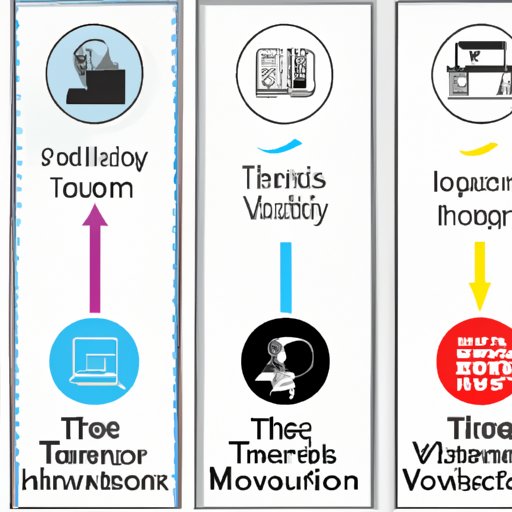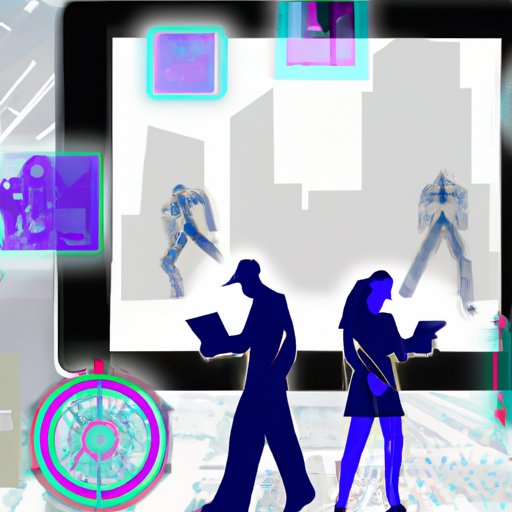Introduction
The term “technological revolution” is used to refer to a period of time in which technology has drastically changed the way people live and work. This period of rapid change and innovation has been occurring since the Industrial Revolution, when advancements in steam-powered machinery and mass production transformed the world. Since then, there have been numerous technological revolutions, with each one ushering in new ways of solving problems and creating opportunities.
In this article, we will explore the history of the technological revolution and examine the key innovations that have shaped the modern world. We will also look at how these changes have impacted society and analyze the causes and consequences of the revolution.

Examining the Technological Revolution: A Timeline of Key Innovations
To better understand the technological revolution, it is important to look at the timeline of key innovations. Let us begin by examining the Industrial Revolution, which took place in the late 18th and early 19th centuries.
Introduction to the Industrial Revolution
The Industrial Revolution began in Britain in the late 1700s and spread to other parts of the world over the following decades. It was characterized by the introduction of new technologies such as steam-powered machinery, which allowed for faster and more efficient production of goods. This increased productivity led to a shift away from agrarian societies and towards the development of cities and towns. As a result, many people moved away from rural areas and into urban centers, leading to an increase in population and economic growth.
Revolutionary Technologies of the 19th Century
Throughout the 19th century, a number of revolutionary technologies emerged. The invention of the telegraph in 1844 enabled instant communication across long distances, while the first electric light bulb was developed in 1879. In addition, the invention of the telephone by Alexander Graham Bell in 1876 revolutionized communication, allowing people to talk to one another over long distances. Moreover, the invention of the typewriter in 1867 made it easier for people to write quickly and accurately.
Technological Developments of the 20th Century
As the 20th century progressed, a number of new technologies emerged. Automobiles and airplanes were developed, allowing for faster transportation. In addition, the invention of the radio in 1901 and the television in 1926 revolutionized media, providing people with access to news, entertainment, and education. Perhaps most importantly, computers were invented in the 1940s and 1950s, paving the way for the development of the Internet in the 1990s.

Exploring the Impact of Technology on Society During the Technological Revolution
The technological revolution has had a profound impact on society. Let us examine the effects of some of the key innovations.
The Impact of Machines and Automation
The introduction of machines and automation has greatly increased productivity and efficiency. According to a study by the International Labor Organization, “automation and machine learning are expected to replace 25 million jobs in the United States by 2030.” This has resulted in a shift from manual labor to computer-based work, which has both positive and negative impacts. On one hand, it has led to higher wages for those who are able to use the new technologies, but on the other hand, it has left those without the necessary skills unemployed.
The Effects of Telecommunications and Computers
Telecommunications and computers have completely changed the way we communicate and interact with one another. Thanks to the Internet, we can now send emails, video chat with friends and family, and access a wealth of information from around the world. According to a report by the Pew Research Center, “nearly nine-in-ten Americans (89%) now go online.” This has enabled us to connect with people from all over the globe, breaking down geographical boundaries and making the world feel much smaller.
Changes in Social Interaction
The technological revolution has also changed the way we socialize. With the rise of social media, people are now able to stay connected with one another in ways that were not possible before. According to a study by the University of Pennsylvania, “social media use has become so pervasive that it is now considered a normal part of everyday life.” However, this has also led to an increase in cyberbullying and other forms of online harassment.

A Look at the History Behind the Technological Revolution
To understand why the technological revolution occurred, it is important to look at the historical context. Let us examine the rise of science and technology, the emergence of the digital age, and the influence of politics and economics.
The Rise of Science and Technology
The technological revolution was driven by the rise of science and technology. During the 17th and 18th centuries, scientists and inventors began to make breakthroughs in understanding the natural world. This led to the development of new technologies, such as the steam engine, which paved the way for the Industrial Revolution.
The Emergence of the Digital Age
The emergence of the digital age in the mid-20th century marked a major turning point for the technological revolution. Computers, which had previously been large and expensive machines, became smaller and more affordable. This allowed for the development of new technologies, such as the Internet, which revolutionized communication and commerce.
The Influence of Politics and Economics
Politics and economics have also played a role in driving the technological revolution. Governments have invested heavily in research and development, while businesses have sought to take advantage of new technologies to increase profits. According to a study by the World Bank, “government spending on research and development rose from $7 billion in 1995 to $10 billion in 2018.”
How Technology Changed Our Lives During the Technological Revolution
The technological revolution has had a profound impact on our lives. Let us examine some of the ways in which technology has changed our lives.
Improved Quality of Life
The introduction of new technologies has improved the quality of life for many people. Automation and robotics have made everyday tasks easier and more efficient, while the Internet has given us access to a wealth of information. Furthermore, advances in medicine and healthcare have helped to reduce mortality rates and improve the overall health of populations.
Shifting Economic Structures
The technological revolution has also had an effect on the global economy. The rise of communication technologies has enabled companies to outsource labor to cheaper markets, while the emergence of e-commerce has enabled businesses to reach new customers. In addition, automation and artificial intelligence have enabled companies to increase efficiency and reduce costs.
Increased Access to Information
The technological revolution has also enabled people to access a wealth of information. The Internet has made it easier to find information on almost any topic, while social media has enabled us to stay connected with people from all over the world. In addition, the rise of mobile devices has made it easier to access the Internet from anywhere.
Analyzing the Causes and Consequences of the Technological Revolution
While the technological revolution has brought about many positive changes, it has also had its share of negative impacts. Let us examine the causes and consequences of the revolution.
Factors Contributing to the Revolution
There are a number of factors that have contributed to the technological revolution. These include the rise of science and technology, the emergence of the digital age, and the influence of politics and economics. In addition, the availability of venture capital and government funding has helped to fuel innovation.
Positive Impacts of Technology
The technological revolution has had numerous positive impacts on society. It has enabled us to stay connected with one another, increased access to information, and improved the quality of life for many people. In addition, it has enabled businesses to become more efficient and profitable.
Negative Impacts of Technology
However, the technological revolution has also had some negative impacts. The automation of labor has led to job losses, while the rise of social media has enabled cyberbullying and other forms of online harassment. In addition, the overuse of technology has been linked to mental health issues, such as depression and anxiety.
Conclusion
The technological revolution has had a profound impact on society. From the invention of the steam engine to the emergence of the digital age, technology has changed the way we live and work. It has enabled us to stay connected with one another, increased access to information, and improved the quality of life for many people. However, it has also had its share of negative impacts, including job losses, cyberbullying, and mental health issues.
In conclusion, the technological revolution has been a complex process with both positive and negative impacts. As technology continues to evolve, it is important to consider the implications of these changes and ensure that they are beneficial for everyone.
(Note: Is this article not meeting your expectations? Do you have knowledge or insights to share? Unlock new opportunities and expand your reach by joining our authors team. Click Registration to join us and share your expertise with our readers.)
